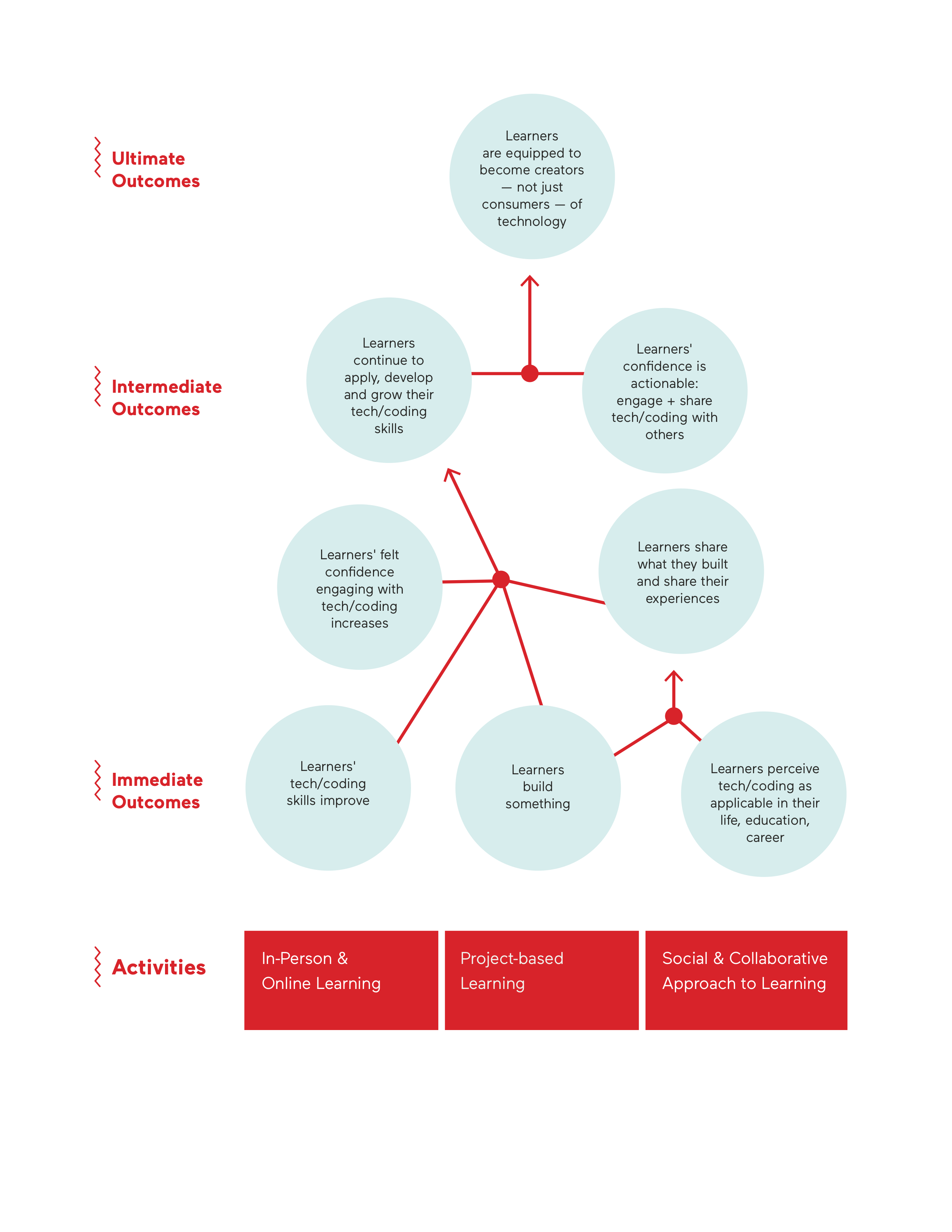Creating a results flow for an indie game studio
Capitalism tells us only financial returns – the bigger, the better! – are important. But it doesn’t have to be this way. Broadening our understanding of what value means can create more sustainable ways of working (and funding that work.)
Capitalistic returns almost always come at a great human and social cost. Extracting as much value as possible necessitates poor pay and working conditions; it keeps value from flowing to workers and really anyone who isn’t at the top.
We don’t just make games and print money. We work with humans who have needs and desires. We make cultural products that live on in players’ imaginations and alter their perspectives; our ideas and work affect individuals and communities in ways we both intend and can’t anticipate.
So how can we account for and value positive social impact in our studio operations?
In our blog post A Brief Intro to Making Your Indie Game Studio Impactful, we explored how you can start thinking about what makes an impactful game studio. (If you haven’t read it, take a moment now to get a grasp on the concept of social impact strategy for indies – it’s not common in our industry!)
We also talked about imagining your dream world, and how to begin thinking about the social impact of what you do:
To start your impact journey, you need to describe your dream-world. What does the planet look like if you are successful in achieving the change you want?
Once you’ve defined your dream world, you need a strategy for making it a reality. Your strategy will align your actions and intended impact within the constraints of the resources you actually have.
What’s a results flow?
So, let’s take a closer look at a tool for planning and measuring your studio’s impact: The results flow, also known as (or similar to) a theory of change, logic model, or results chain. This tool will help you visualize the chronological (and logical) sequence of events – from activities to outcomes – that lead to your ultimate desired impact. It’s a visual roadmap that illustrates what you need to do and what you expect to achieve.
The cool thing about a results flow is that it can incorporate all of your studio’s goals and activities, not just those oriented toward social impact. It also:
- Helps us predict what actions we need to take and resources we need to move towards our intention logically and visually.
- Is the basis for measurement, and a way to ensure your whole organization is on the same page.
- Is an agreement between partners, workers, creators, and the communities you work with on what success looks like and what you want to achieve along the way.
- Is a compelling story for everyone you want to support you (your team, investors, players, media, the public).
We’ll guide you through the process of developing your own results flow. First, we’ll clarify some key concepts, then walk you through crafting your intended impact statement, drafting an ultimate outcome statement, and creating your results flow through backward mapping. We’ll also get into how to inventory your activities, refine your diagram, and evaluate its realism and logic.
This guide, aimed at folks just embarking on their impact journey, will give you some practical advice and clear steps to help you on your way. We hope it will lead you to think deeply about the impact of your games and how your studio operates.
So, let’s start developing a results flow for your studio!
Understanding key concepts
First, let’s clarify some key terms we’ll use throughout this guide. These concepts form the backbone of your social impact strategy and will help you articulate and measure your studio’s impact.
- Activities: The specific actions, initiatives, core tasks, and projects that your studio engages in.
- Outputs: These are the direct products of your activities. They are the tangible and intangible goods or services produced from your work (e.g., a published game, a completed client project, or a social media campaign).
- Inputs: These are the resources you need to carry out your activities (e.g., funding, collaborators, audience research, computers).
- Intended impact: This is the change you will be accountable for. It’s a hypothesis about what will lead to your desired ultimate outcome. Your intended impact statement is not about your activities, projects, or strategy but rather the change you aim to make. It’s about defining success for your studio and committing to your activities and outputs. It should clearly describe what you will achieve, who will benefit, and by when.
- Ultimate outcome statement: This describes how the world looks if you are successful. It’s a vision of your dream world — how it would be if you achieved the desired change. You should word your ultimate outcome statement in the present tense and not worry about the scope or scale. What feels right — is right! It doesn’t have to feel achievable or realistic right now.
- Results flow: Also known as a theory of change or results chain, a results flow is a visual map of the sequence of events – from activities to outcomes – that lead to your ultimate outcome. It illustrates what you need to do and what you expect to achieve along the way.
Understanding these concepts is the first step in developing a results flow for your studio. In this article, we’ll get into the details of how these elements relate and how you can use them to plan and implement your studio’s social impact strategy.
Crafting your intended impact statement
Your intended impact statement is the starting place for developing your results flow and informs your entire social impact strategy. It’s not about activities, projects, or strategies. It’s about defining success for your studio. It’s about the change you will make. And it should clearly describe what you will achieve, who benefits, and by when.
You need to understand your dream world to start crafting your intended impact statement. What do things look like if you are successful? Now get specific: What is the timeline, who is impacted, and what will be achieved? Being clear about when, who, and what is critical because it embeds the potential for accountability into your dream world and makes it possible to create a workback plan and determine what resources are needed to get there.
Consider:
- What change will you make? This is about the specific outcomes you’re aiming for. What change do you want to see in the world due to your studio’s work?
- Who benefits? Consider your target population, identity, and geography. Who are the people or communities that will benefit from the change you’re aiming to make?
- By when? What is the timeframe for achieving this impact? Aim for 2-7 years. This helps to keep your goals realistic and achievable.
For example:
By 2026, our studio will cultivate acceptance and understanding of Gen Z LGBTQIA+ perspectives among at least 40,000 players through our games that feature diverse characters and inclusive narratives.
Remember, your intended impact statement is not about the activities you’re doing. It’s about the specific results of your activities. It’s how you move from what we do to what we contribute. This clarity will push you to maintain focus and sets the stage for allowing your team to be held accountable.
Take some time to draft your intended impact statement. Don’t worry about perfecting it at this stage. Just try to get these three elements defined. Review and refine your draft statement once you’re happy with it. Share this process with your team and integrate their feedback.
Note the difference between a mission or vision statement and an intended impact statement. A mission or vision statement is broad and idealistic, focusing on what the studio is doing rather than the outcome of its work. An intended impact statement, on the other hand, is specific and measurable, focusing on the change you will make, who benefits, and by when.
Drafting an ultimate outcome statement
When you’re happy with your intended impact statement, it’s time to draft your ultimate outcome statement. This statement is the full, boundless vision of your dream world – how it would be if you successfully achieved the change you want. It’s about imagining the broadest impact of your work and how it contributes to the world you want to see.
Here’s how to approach drafting your statement:
- Imagine your dream world: Don’t limit yourself by doubting whether it’s possible or wondering where you’ll get the resources – focus on what feels ideal to you. This is your chance to dream big and articulate the world you want to help create!
- Use present tense: This helps to make it more tangible and real as if it’s already happening. It makes it easier to understand whether or not you’ve achieved this goal later down the line.
- Keep it pithy: It doesn’t need to be long – it’s often more powerful when short and precise. Try distilling your vision to its essence, capturing the heart of your goals as a studio.
Here’s an example:
LGBTQIA+ identities are understood and accepted in games, mirroring a society that celebrates diversity and inclusion.
While your intended impact statement is about the specific, measurable change you’re committing to make, your ultimate outcome statement is about the broader impact of your work and the world you want to see.
Take your time with this step. Try to capture your vision as clearly as you can. Once you’ve drafted your statement, work on honing it with your team until it feels right. It could take days or weeks to arrive at something resonant.
Inventorying your activities
Inventorying your activities is next – don’t worry, we’re getting close to actually creating your results flow! This step involves identifying your studio’s different core activities and understanding the outputs associated with each activity.
Identify your activities
First: List all the different activities that your studio does or offers. Think game development, porting services, writing articles, education and outreach, researching, or developing relationships with communities. Think beyond game production — what other types of tasks and projects do you or want to do?
Once you have a complete list, whittle it down to your primary 3-5 activities. (Don’t stop doing the rest. We’re just identifying which activities are central to your studio’s operations and impact.) Ask yourself: Can some activities be combined? Are there activities that are essentially part of the same process or aim at the same outcomes?
Understand the outputs
Label the associated outputs for each core activity you’ve identified. For example, if one of your activities is game development, the output is a published game. The output could be a completed client project if you’re offering porting services. If you’re writing articles, the output is a published article.
Your outputs are the tangible results of your activities that lead directly to outcomes. They are the evidence of your work and the first step towards making your intended impact.
The goal of inventorying your activities is not just to have a list of what you do but to lay the groundwork for mapping these activities to your intended ultimate outcome. This understanding will help you refine your results flow and ensure that your actions will lead to your desired outcomes.
Examples
Here’s an example of a results flow from Weird Ghosts to help you visualize what we’re aiming for:
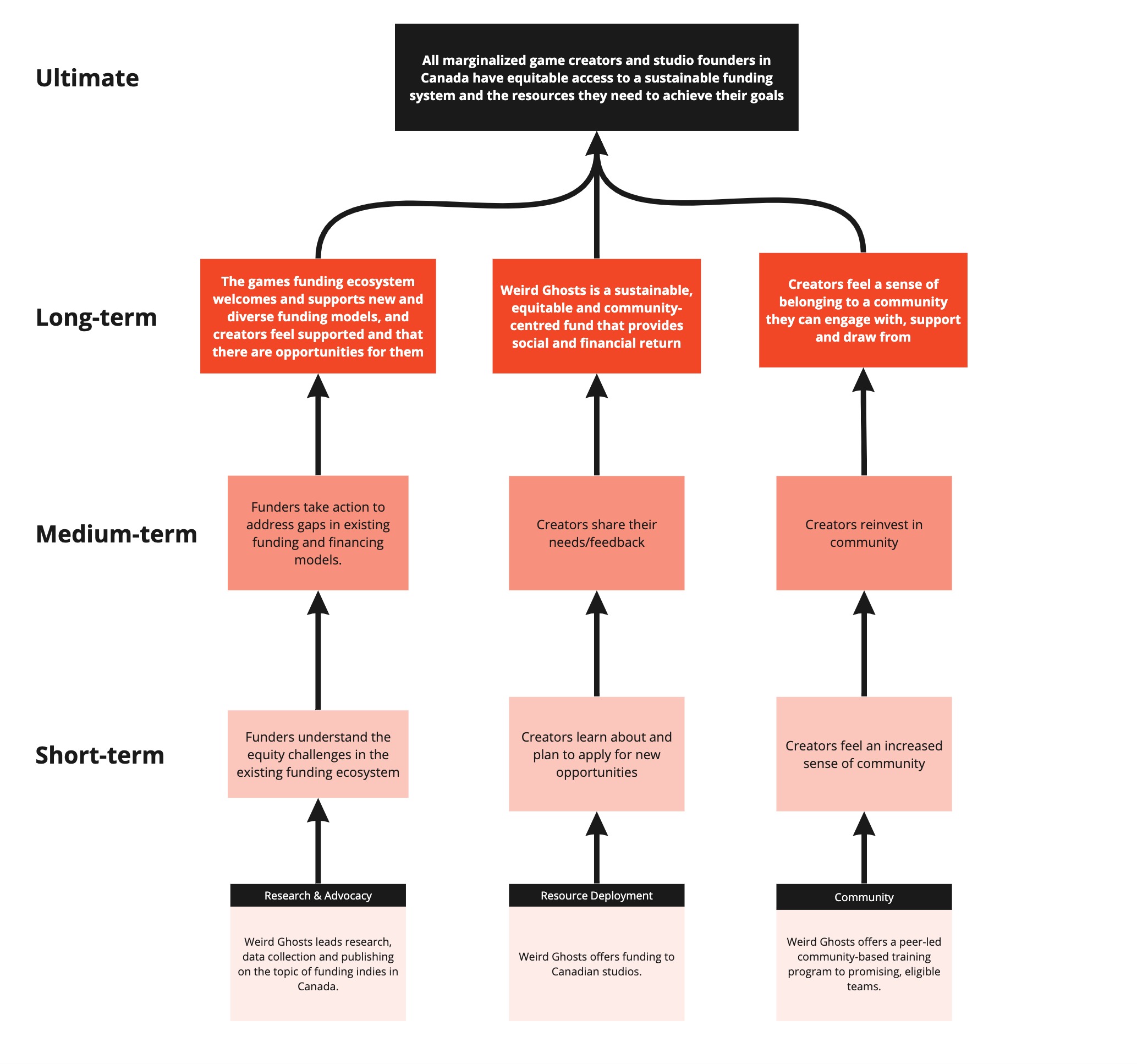
To illustrate that your diagram can be formatted differently, here is Mozilla’s Theory of Change:
_%E2%80%93_Landscape_Design.jpg)
And Furniture Bank’s more illustrative diagram:
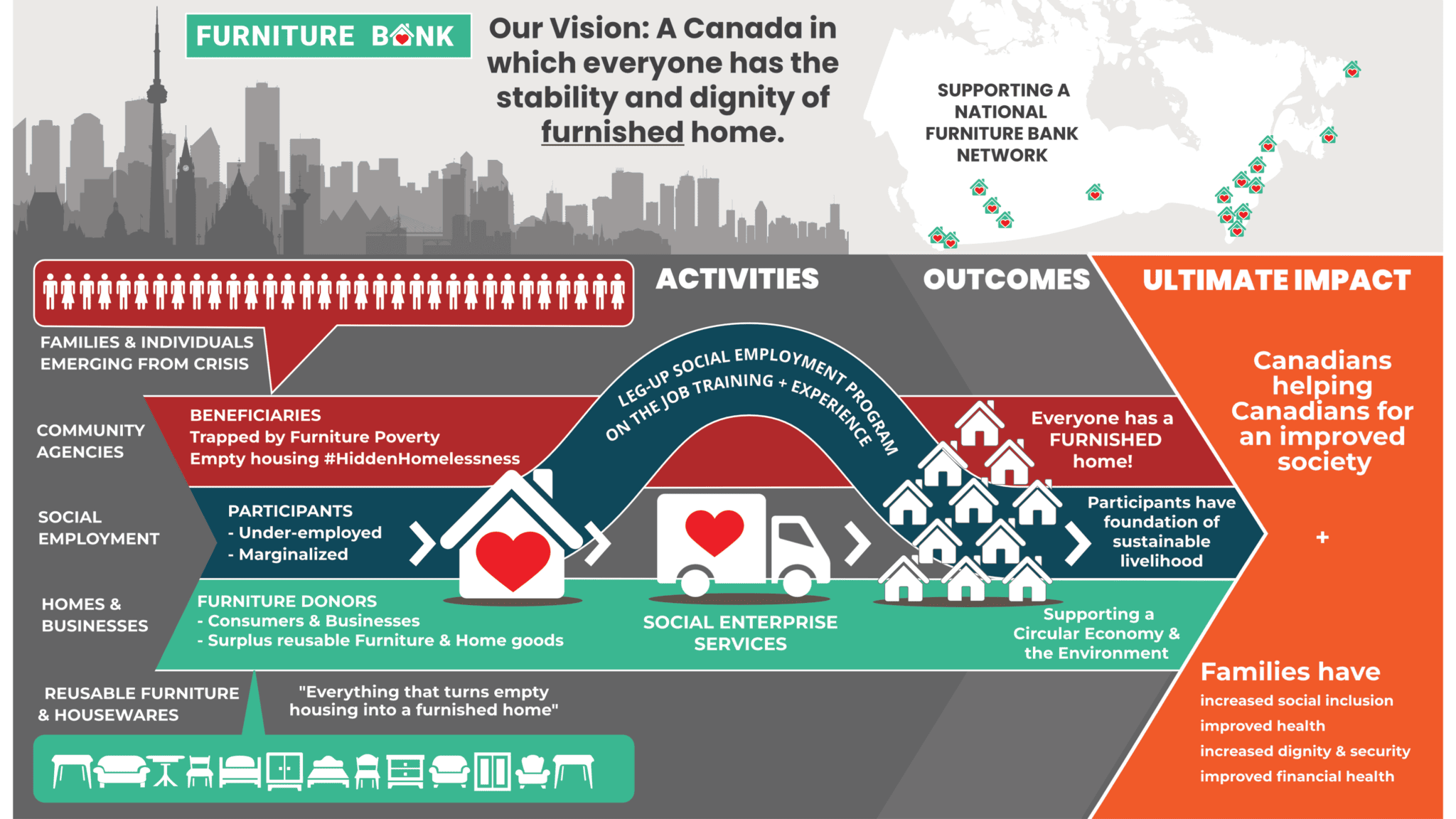
Backward mapping: Creating your results flow
Backward mapping is a strategic planning process that starts with your ultimate outcome and works back to connect it to the activities you’ve identified in the previous step. This approach ensures that everything you do is aligned with your ultimate goal.
Here’s how to create your results flow through backward mapping:
Start with your ultimate outcome
Begin by stating your ultimate outcome. Place it at the top of your workspace in a visual tool like Miro. In addition to the above, another example is Weird Ghosts’ ultimate outcome: “All marginalized game creators and studio founders in Canada have equitable access to a sustainable funding system and the resources they need to achieve their goals.” (Psst… if you use Miro, copy this board to get started really fast!)

Identify your activities
Next, place your core activities at the bottom of your workspace. You identified 3-5 of these in the previous step. An example: One of Weird Ghosts’ core activities is offering a peer-led community-based training program. Another example could be “Developing games that feature LGBTQIA+ characters and narratives.” In the diagram below, we’ve also created labels for each pillar.
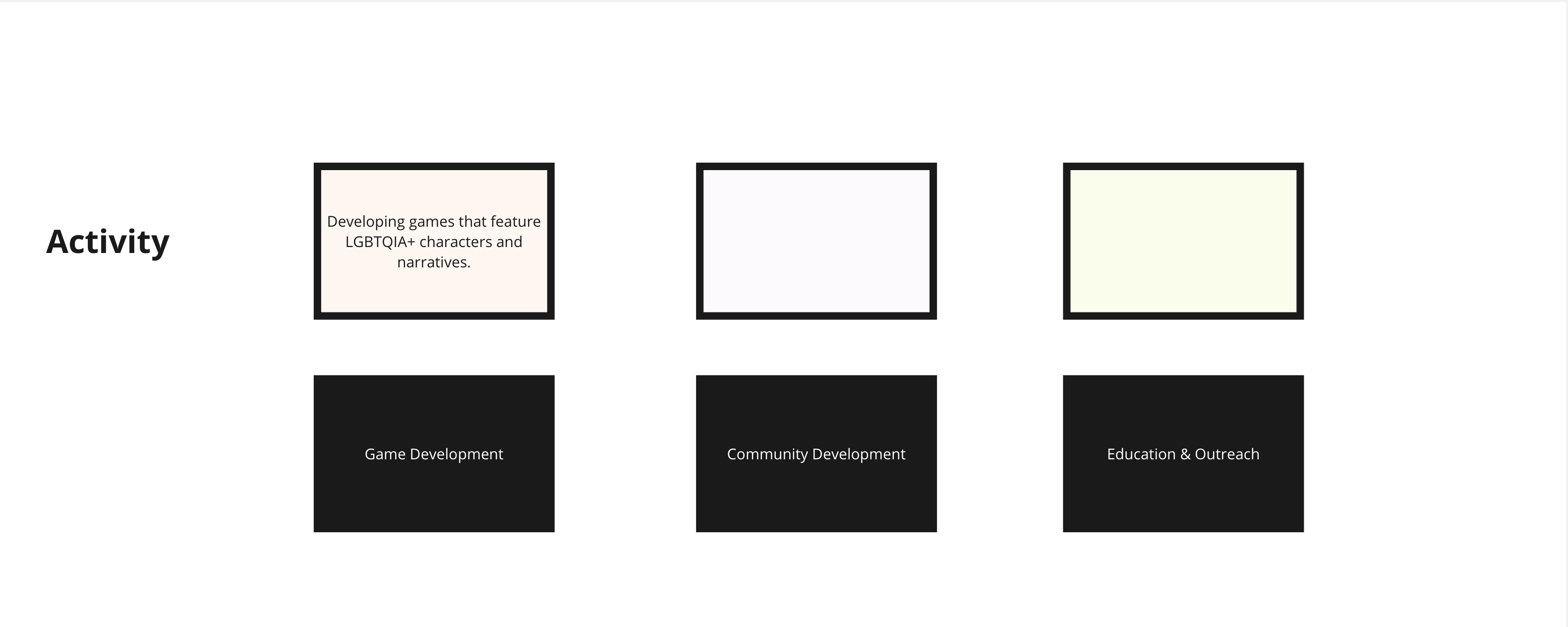
Brainstorm long-, medium-, and short-term outcomes
For each activity, brainstorm the outcomes you expect to see in the short, medium, and long term. These outcomes should be a direct result of your activities and point toward your ultimate outcome.
- Short-term outcomes are the immediate effects of your activities – changes in skills, knowledge, awareness, interests, and motivation. For example, a short-term outcome of Weird Ghosts’” Community” activity is that creators feel an increased sense of community. In the case of developing games that feature LGBTQIA+ characters and narratives, a short-term outcome could be “Players gain exposure to diverse characters and narratives.”
- Medium-term outcomes are the changes in action, behaviour, practice, and attitude that result from the short-term outcomes. For Weird Ghosts, a medium-term outcome is that creators reinvest in the community. A medium-term outcome for the game development activity might be “Players develop empathy and understanding towards LGBTQIA+ identities.”
- Long-term outcomes are the changes in state or condition that result from the medium-term outcomes. A long-term outcome for Weird Ghosts is that creators feel a sense of belonging to a community they can engage with, support, and draw from. In the case of the game development activity, a long-term outcome could be “Players advocate for LGBTQIA+ rights and inclusion.”
In your visual workspace, draw three columns or pillars below your ultimate outcome for these long-term, medium-term, and short-term outcomes. Place the long-term outcomes closest to the ultimate outcome and the short-term outcomes at the bottom.

Map outcomes to activities
Now, draw lines to connect your activities to your short-, medium- and long-term outcomes and those to your ultimate outcome. Each line represents a step in your results flow, showing how each activity and outcome contributes to your ultimate outcome.
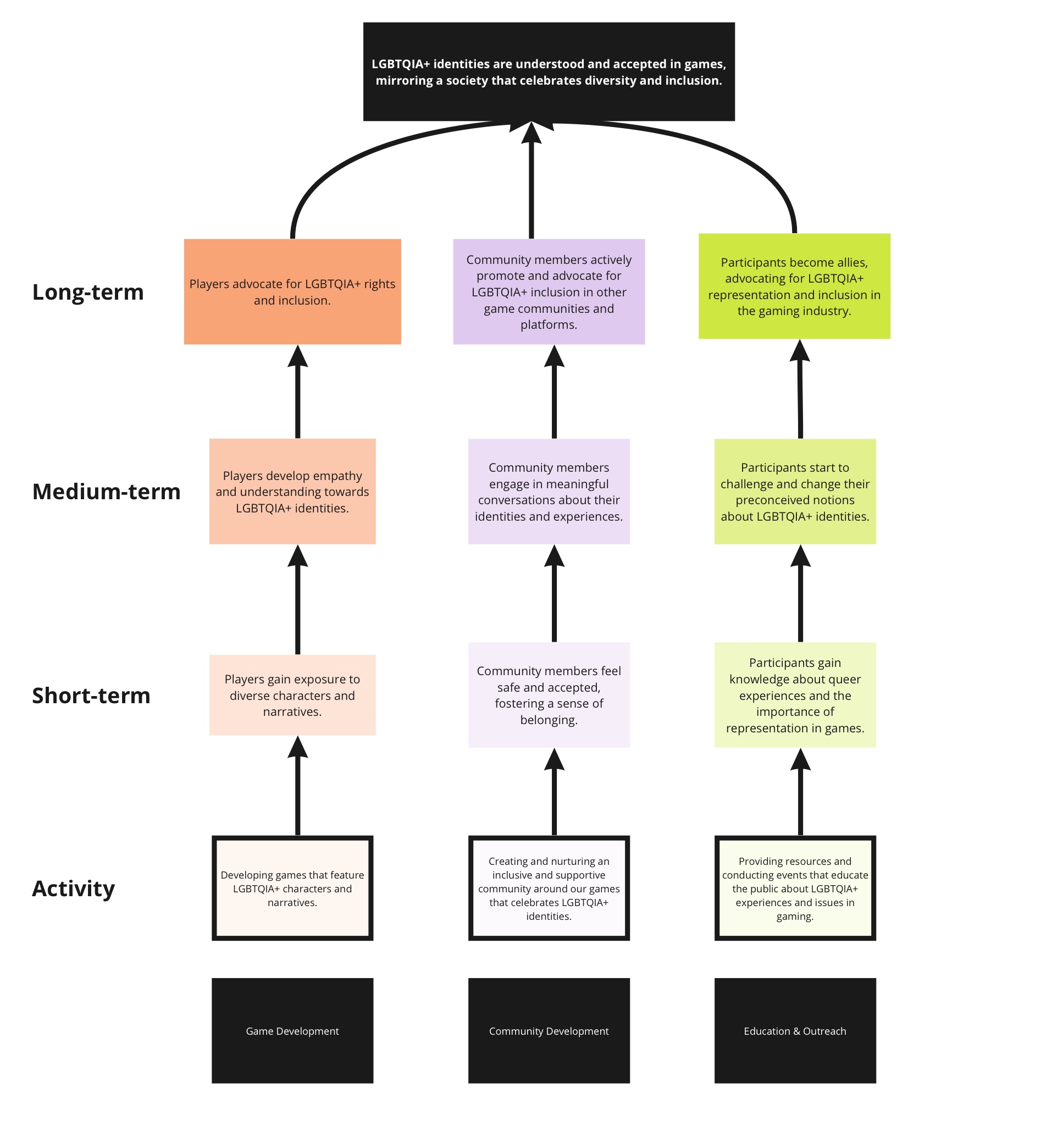
This process will require some iteration as you make connections between your activities and outcomes and refine your outcomes to be as clear (hint: and as measurable) as possible. It’s okay if it’s not perfect on the first try – this is a living document. We just updated Weird Ghosts’ last month!
By the end of this process, you should have a clear visual representation of your results flow, showing how your activities lead to your ultimate outcome. This will be a critical tool for planning, implementing, and evaluating your studio’s impact. You can read more about that in our article Developing Your Impact Measurement Framework
Refining your results flow
Once you’ve drafted your results flow (woo! 🙌), you can further refine it. Let’s talk about it.
Identifying necessary resources
To pursue your outcomes, you’ll need to ensure you have the right resources in place. Think funding, hiring artists, audience data, and the right graphics cards for your team. Reflect on each activity and outcome in your results flow and ask yourself: Do we have what we need to make this happen? If not, what’s missing, and how can we secure it?
Considering activities to start or stop
You might realize that there are activities you’re currently doing that don’t contribute to your ultimate outcome. Or, you might identify new activities that could help you achieve your desired outcomes. This is a time for honest evaluation and (potentially) tough conversations. Don’t be afraid to stop activities that aren’t serving your goals or start new ones that will. For example, you might decide to stop certain marketing activities that aren’t reaching your target audience or to start a new partnership with a community organization that offers support your team can’t alone. (Like our partnership with Gamma Space to deliver the Baby Ghosts program).
Prioritizing what is necessary now
While planning for the long term, figuring out what to do now is also crucial. You don’t need to implement every single column/pillar in your results flow right away. Instead, prioritize the activities and outcomes that are most urgent or doable in the short term. This will help you conserve and build up energy and resources, putting you in a better position to tackle your long-term goals.
Reflecting on your results flow
You’ve refined your results flow – now it’s time to evaluate it. You’ll check the realism and logic of your diagram and identify the outcomes you will hold yourself accountable for achieving.
Checking the realism and logic
Start by considering the feasibility of your plan. Ask yourself: Are the proposed activities likely to lead to the expected outputs? Are the connections between activities, outputs, and outcomes logical and realistic? Will we be able to secure the resources we need to pursue these outcomes?
For example, if one of your activities is “Developing games that feature LGBTQIA+ characters and narratives,” and a short-term outcome is “Players gain exposure to diverse characters and narratives,” consider whether this activity will realistically lead to this outcome. Will your target audience likely play your games and be exposed to diverse narratives? What will you do to engage this audience directly?
Also, consider the logic of your outcomes. Do your short-term outcomes logically lead to your medium-term outcomes, and do those logically lead to your long-term outcomes? For example, does gaining exposure to diverse narratives logically lead to developing empathy and understanding (a medium-term outcome), and does that logically lead to advocating for LGBTQIA+ rights and inclusion (a long-term outcome)? Consider the nuances that need to be present in your work to lead to each outcome.
Identifying outcomes you will hold yourself accountable for achieving
Next, decide which outcomes on your results chain you will commit to achieving and, therefore measuring. This is about setting clear commitments and holding yourself accountable.
For example, you might decide to hold yourself accountable for the short-term outcome of “Players gain exposure to diverse characters and narratives.” This means you would need to find ways to measure this outcome, such as through player surveys, feedback, discussion forums, and app analytics.
Remember, it’s okay to adjust your results flow based on this evaluation. The goal is to create a roadmap that is both a realistic plan and a valuable tool for accountability.
In conclusion…
We’re so proud of you for taking this step toward understanding and planning the social impact of your indie game studio. By developing a results flow, you’re mapping the path from what you do to actually changing the world and creating a vital internal tool that will guide your actions, help you measure your progress, and hold you accountable. Your players, investors, and community will actually love you for it.
You’ll revisit, revise, and refine your results flow as your studio grows, as you learn more about your impact, and as the ecosystem changes (because of you!). It reflects your studio’s values, and you should share it with the world!
We hope we’ve inspired you to think ever more deeply about the impact of your games and how you make them. Embrace the whole process, refer to your results flow regularly and let it guide your core work.
In the next article in this series, we cover creating your impact measurement framework.
We can’t wait to see the impact you’ll make!
Additional resources
- Miro Results Flow template
- Want a quick evaluation of your results flow and ultimate outcome statement? We’d be happy to take a look and provide actionable feedback. Drop us a line.
- Looking for funding for your impactful game studio? Even if you’re just starting your impact journey, we’d love to hear from you.
Acknowledgments
Warm thanks to:
- datejie cheko green of Gamma Space for coining the term “results flow” to replace the term” results chain.” We adopted this term to avoid imagery associated with white supremacy and underscore the fluid rather than rigid nature of the links between outcomes.
- And the support of Lift Philanthropic Partners for their impact training
